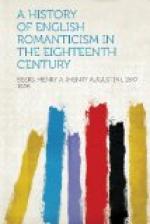“‘Dreading the demon of the grove to meet.’
“Who that sees the sable plumes waving on the prodigious helmet in the Castle of Otranto, and the gigantic arm on the top of the great staircase, is not more affected than with the paintings of Ovid and Apuleius? What a group of dreadful images do we meet with in the Edda! The Runic poetry abounds in them. Such is Gray’s thrilling Ode on the ‘Descent of Odin.’”
Warton predicts that Pope’s fame as a poet will ultimately rest on his “Windsor Forest,” his “Epistle of Eloisa to Abelard,” and “The Rape of the Lock.” To this prophecy time has already, in part, given the lie. Warton preferred “Windsor Forest” and “Eloisa” to the “Moral Essays” because they belonged to a higher kind of poetry. Posterity likes the “Moral Essays” better because they are better of their kind. They were the natural fruit of Pope’s genius and of his time, while the others were artificial. We can go to Wordsworth for nature, to Byron for passion, and to a score of poets for both, but Pope remains unrivaled in his peculiar field. In other words, we value what is characteristic in the artist; the one thing which he does best, the precise thing which he can do and no one else can. But Warton’s mistake is significant of the changing literary standards of his age; and his essay is one proof out of many that the English romantic movement was not entirely without self-conscious aims, but had its critical formulas and its programme, just as Queen Anne classicism had.
[1] Dr. Johnson had his laugh at this popular person:
“’Hermit hoar,
in solemn cell
Wearing out life’s evening
gray,
Strike thy bosom, sage, and
tell
What is bliss, and which the
way?’
“Thus I spoke, and speaking sighed, Scarce suppressed the starting tear: When the hoary sage replied, ‘Come, my lad, and drink some beer.’”
[2] “Grose’s Antiquities of Scotland” was published in 1791, and Burns wrote “Tam o’Shanter” to accompany the picture of Kirk Alloway in this work. See his poem, “On the late Captain Grose’s Peregrinations through Scotland.”
[3] “Ragnaroek,” or “Goetterdaemmerung,” the twilight of the Gods




